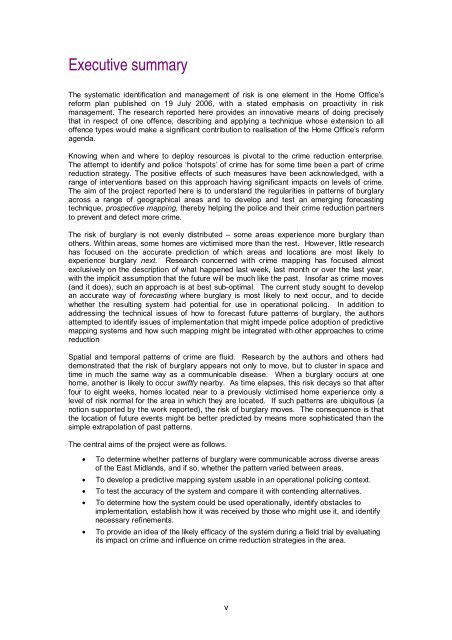Prospective crime mapping in operational context Final report
Prospective crime mapping in operational context Final report
Prospective crime mapping in operational context Final report
- No tags were found...
You also want an ePaper? Increase the reach of your titles
YUMPU automatically turns print PDFs into web optimized ePapers that Google loves.
Executive summaryThe systematic identification and management of risk is one element <strong>in</strong> the Home Office’sreform plan published on 19 July 2006, with a stated emphasis on proactivity <strong>in</strong> riskmanagement. The research <strong>report</strong>ed here provides an <strong>in</strong>novative means of do<strong>in</strong>g preciselythat <strong>in</strong> respect of one offence, describ<strong>in</strong>g and apply<strong>in</strong>g a technique whose extension to alloffence types would make a significant contribution to realisation of the Home Office’s reformagenda.Know<strong>in</strong>g when and where to deploy resources is pivotal to the <strong>crime</strong> reduction enterprise.The attempt to identify and police ‘hotspots’ of <strong>crime</strong> has for some time been a part of <strong>crime</strong>reduction strategy. The positive effects of such measures have been acknowledged, with arange of <strong>in</strong>terventions based on this approach hav<strong>in</strong>g significant impacts on levels of <strong>crime</strong>.The aim of the project <strong>report</strong>ed here is to understand the regularities <strong>in</strong> patterns of burglaryacross a range of geographical areas and to develop and test an emerg<strong>in</strong>g forecast<strong>in</strong>gtechnique, prospective <strong>mapp<strong>in</strong>g</strong>, thereby help<strong>in</strong>g the police and their <strong>crime</strong> reduction partnersto prevent and detect more <strong>crime</strong>.The risk of burglary is not evenly distributed – some areas experience more burglary thanothers. With<strong>in</strong> areas, some homes are victimised more than the rest. However, little researchhas focused on the accurate prediction of which areas and locations are most likely toexperience burglary next. Research concerned with <strong>crime</strong> <strong>mapp<strong>in</strong>g</strong> has focused almostexclusively on the description of what happened last week, last month or over the last year,with the implicit assumption that the future will be much like the past. Insofar as <strong>crime</strong> moves(and it does), such an approach is at best sub-optimal. The current study sought to developan accurate way of forecast<strong>in</strong>g where burglary is most likely to next occur, and to decidewhether the result<strong>in</strong>g system had potential for use <strong>in</strong> <strong>operational</strong> polic<strong>in</strong>g. In addition toaddress<strong>in</strong>g the technical issues of how to forecast future patterns of burglary, the authorsattempted to identify issues of implementation that might impede police adoption of predictive<strong>mapp<strong>in</strong>g</strong> systems and how such <strong>mapp<strong>in</strong>g</strong> might be <strong>in</strong>tegrated with other approaches to <strong>crime</strong>reductionSpatial and temporal patterns of <strong>crime</strong> are fluid. Research by the authors and others haddemonstrated that the risk of burglary appears not only to move, but to cluster <strong>in</strong> space andtime <strong>in</strong> much the same way as a communicable disease. When a burglary occurs at onehome, another is likely to occur swiftly nearby. As time elapses, this risk decays so that afterfour to eight weeks, homes located near to a previously victimised home experience only alevel of risk normal for the area <strong>in</strong> which they are located. If such patterns are ubiquitous (anotion supported by the work <strong>report</strong>ed), the risk of burglary moves. The consequence is thatthe location of future events might be better predicted by means more sophisticated than thesimple extrapolation of past patterns.The central aims of the project were as follows.• To determ<strong>in</strong>e whether patterns of burglary were communicable across diverse areasof the East Midlands, and if so, whether the pattern varied between areas.• To develop a predictive <strong>mapp<strong>in</strong>g</strong> system usable <strong>in</strong> an <strong>operational</strong> polic<strong>in</strong>g <strong>context</strong>.• To test the accuracy of the system and compare it with contend<strong>in</strong>g alternatives.• To determ<strong>in</strong>e how the system could be used <strong>operational</strong>ly, identify obstacles toimplementation, establish how it was received by those who might use it, and identifynecessary ref<strong>in</strong>ements.• To provide an idea of the likely efficacy of the system dur<strong>in</strong>g a field trial by evaluat<strong>in</strong>gits impact on <strong>crime</strong> and <strong>in</strong>fluence on <strong>crime</strong> reduction strategies <strong>in</strong> the area.v
















